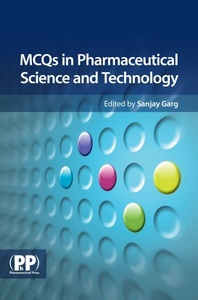Pharmacokinetics and biopharmaceutics
Perumal, Omathanu P., Haywood, Alison, Glass, Beverley, and Ho, Paul Chi-Lui (2011) Pharmacokinetics and biopharmaceutics. In: Garg, Sanjay, (ed.) MCQs in Pharmaceutical Science and Technology. Pharmaceutical Press, London, UK, pp. 41-86.
![[img]](https://researchonline.jcu.edu.au/23399/2.hassmallThumbnailVersion/23399_Peruman_et_al_2011_Book_Cover.jpg)
|
Image (JPEG) (Book Cover)
- Cover Image
Download (70kB) |
|
|
PDF (Published Version)
- Published Version
Restricted to Repository staff only |
Abstract
[Extract] Oral dosage forms are widely used due to the convenience of drug administration. There are several steps a dosage form/delivery system has to undergo before it produces a therapeutic response. This can be explained by the LADMER system which includes liberation of a drug from the dosage form, absorption of the drug, distribution of the drug, metabolism of the drug, excretion of the drug and finally the response. Biopharmaceutics deals with the study of physiochemical and physiological factors that influence the liberation and absorption of drugs from different dosage forms. Pharmacokinetics deals with the absorption, distribution, metabolismn and excretion of a drug; the study of drug response is known as pharmacodynamics. In simple terms, biopharmaceutics is what the pharmceutical scientist does to the drug, pharmacokinetics is what the body does to the drug, and pharmadynamics is what the drug does to the body. Optimisation of biopharmaceutics and pharmacokinetic properties plays a significant role in the development of new drugs. This can be exemplified by the fact that 40% of drug candidates do not make it to market because of poor biopharmaceutical and pharmacokinetic properties. Drug solubility and permeability are the two most important biopharmaceutical properties that influence drug absorption and oral bioavailability. This led to the biopharmaceutics classification system (BCS), which classifies drugs into four classes based on their aqueous solubility and permability. These two properties are determined by sthe drug's physicochemical properties, such as its chemical structure, molecular weight, pKa, partition coefficient, crystal structure and particle size, among others. Drugs with good aqueous solubility and membrane permeability generally show good oral absorption and bioavailability provided the drug is stable in the gastrointestinal tract and does not undergo first-pass metabolism in the liver. Several technologies have emerged to address the poor solubility and permeability of drugs. The important pharmacokinetic parameters that influence the biological performance of dosage forms are volume of distribution, half-life, clearance and fraction absorbed. The volume of distribution and clearance influence the drug's half life, which in turn governs the frequency of drug administration. Clearance and fraction absorbed influence the bioavailability, which in turn determines the dose of a drug. Depending on how the drug is distributed into the body, different mathematical models can be used to characterise the drug disposition and estimate the pharmacokinetic parameters. In oral modified-release systems when or where the drug is released in the gastrointestinal tract is modified. These systems can be broadly divided into delayed-release systems aned extended release systems. In the case of delayed-release systems, the drug release is delayed but not sustained. In the case of extended-release systems, the drug release is sustained or controlled with respect to time, thus reducing the frequency of administration.
| Item ID: | 23399 |
|---|---|
| Item Type: | Book Chapter (Teaching Material) |
| ISBN: | 978-0-85369-913-2 |
| Date Deposited: | 30 Oct 2012 01:08 |
| FoR Codes: | 11 MEDICAL AND HEALTH SCIENCES > 1115 Pharmacology and Pharmaceutical Sciences > 111599 Pharmacology and Pharmaceutical Sciences not elsewhere classified @ 100% |
| SEO Codes: | 92 HEALTH > 9299 Other Health > 929999 Health not elsewhere classified @ 100% |
| Downloads: |
Total: 806 Last 12 Months: 11 |
| More Statistics |



